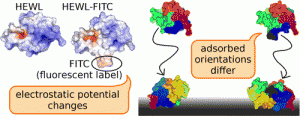When the Label Matters: Adsorption of Labeled and Unlabeled Proteins on Charged Surfaces

Julia Romanowska, Daria B. Kokh, and Rebecca C. Wade
Nano Letters Article ASAP ‘. Copyright (2015) American Chemical Society.
Fluorescent labels are often attached to proteins in order to experimentally study their binding and adsorption to flat surfaces. Ideally, these labels would not change the binding or adsorption features of proteins, so that experimentalists could interpret the data from the labelled proteins as if they came from the unlabelled ones. Usually, it is difficult to compare these two protein species in a laboratory. In an article in Nano Letters by Julia Romanowska, Daria Kokh and Rebecca Wade, computations were used to evaluate the influence of label attachment on an adsorption process of the protein hen egg white lysozyme (HEWL). Although the modified protein, HEWL-FITC, has a relatively small fluorescent label attached, it was found that this changes the protein’s surface charge distribution, which then disrupts the adsorption onto a charged surface. Therefore, it is important when interpreting the results of experiments with labelled proteins, that both protein species are accounted for. This can be done quite easily with relatively straightforward computational methods, as shown in the article.
When the Label Matters: Adsorption of Labeled and Unlabeled Proteins on Charged Surfaces
Julia Romanowska, Daria B. Kokh, and Rebecca C. Wade
Nano Letters Article
DOI: http://dx.doi.org/10.1021/acs.nanolett.5b03168
About HITS
HITS, the Heidelberg Institute for Theoretical Studies, was established in 2010 by physicist and SAP co-founder Klaus Tschira (1940-2015) and the Klaus Tschira Foundation as a private, non-profit research institute. HITS conducts basic research in the natural, mathematical, and computer sciences. Major research directions include complex simulations across scales, making sense of data, and enabling science via computational research. Application areas range from molecular biology to astrophysics. An essential characteristic of the Institute is interdisciplinarity, implemented in numerous cross-group and cross-disciplinary projects. The base funding of HITS is provided by the Klaus Tschira Foundation.